
History Section

Black History in Jersey
L'Histouaithe des Nièrs en Jèrri
Pompey
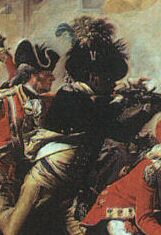 Detail from "The Death of Major Peirson" by John Singleton Copley
|
At the time British military prowess was perceived as having suffered serious reverses. The triumph of the Battle of Jersey was seized upon for its propaganda value and meant that Copley's painting received immediate popularity when first exhibited in London. Peirson's status of hero, dying as he did at the moment of victory, was depicted in a way that almost resembles a Deposition from the Cross.
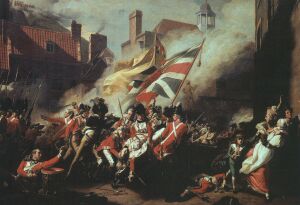 "The Death of Major Peirson" by John Singleton Copley |
Pompey's presence in the image also points to the representation of the far-flung emergent British Empire, its resources and power, being brought to bear for military victory in a small corner of the British Empire. Despite the contemporary loss of American colonies, Britain's overseas possessions provided the necessary muscle to fight off Continental threats. The inclusion of Pompey is not accidental in terms of symbolism.
One should not overlook that the French forces on that day also included a colonial presence.
A copy of the painting hangs in the Royal Court and in the Town Hall. It also appears on the reverse of the £10 note:

Jean L'Blianc
According to the Dictionnaire Jersiais-Français, at the end of the C18th or beginning of the C19th there was a black man living in St. Brelade. He had come to the Island when very young and spoke Jèrriais perfectly. He was nicknamed ironically Jean L'Blianc.
Tchestqu'ch'est qu'un négre?
“Tchestqu'ch'est qu'un négre, Papa?” j'lî d'mandit:
“Eh bein, man p'tit,” i' m'rêponnit: “Ch'est un nièr homme!”
“Mais, Papa,” j'lî dit, “N'y'à pas d'nièrs hommes!”
“Mais ci, l'y'en a, man p'tit,” m'rêponnit Papa: “Le Bouan Dgieu a fait d's'hommes de toutes les couleurs, - des bliancs, des nièrs, des rouoges et des jaunes.”
“Mais combein nier, Papa?” j'lî d'mandit.
“Eh bein, man p'tit, aussi nièr comme le graie!” Papa m'rêponnit.
“Oh! mais! Papa,” j'lî dît: “J'voudrais bein en vaie iun, mé!”
“Et bein!” m'dît Papa. “Si tu'est un bouan garçon, j'îthons en ville tchique Samedi en vaie iun, un négre!”
I' faut craithe que j'tais bouan garçon, car tchiques mais pus tard, nouos v'là aller en ville, Papa et mé, pour vaie l'négre. I' tait à travailli sus la cauchie. Ch'tait un bieau négre, étou, un grand gâs tch'avait nom Fêlix. Et i' tait nièr comme d'la sie. I' m'sembl'ye que j'lé vait acouo acheteu! I' l'vait des bathîs comme si ch'tait des pannièrs!
Combein d'fais qu'j'ait pensé d'pis qu'chu pouorre négre-là d'vait être un objet d'tchuthiosité pour touos les mousses d'la campagne, car ch'est seux qu'y'en avait des chents tchi v'naient en ville à l'exprés pour le vaie.
George F. Le Feuvre
Chroniques de Jersey 15/5/1947 - the action described in the anecdote must be assumed as being set at the end of the C19th
La Négresse Blanche - The White Negress
Advertisements in La Chronique de Jersey in February 1819:
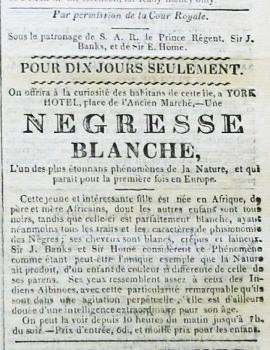
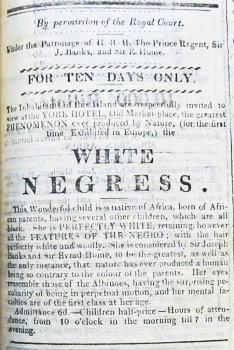
John Jea
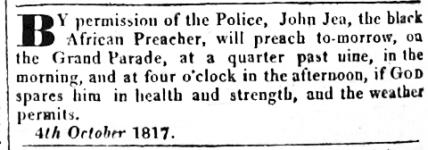
By permission of the Police, John Jea, the black African Preacher, will preach to-morrow, on the Grand Parade, at a quarter past nine, in the morning, and at four o'clock in the afternoon, if GOD spares him in health and strength, and the weather permits.
La Chronique de Jersey 4th October 1817
Benson
M. Benson, un homme de couleur venant d'Amérique, doit prêcher demain dans la chapelle Zion d'Union-street...
Chronique de Jersey 5/11/1853
Rev. J.H. Hector
Nouvelle Chronique de Jersey 30/6/1897
Le Rév. J.H. Hector, le “Chevalier Noir,” prêcha Dimanche dernier dans la Chapelle Wesleyenne de Grove Place, en présence de congrégations nombreuses. Au service du matin (ayant d'abord fait une allocution aux enfants de l'école du Dimanche) M. Hector parla sur les mots “Lave moi et je serai plus blanc que la neige” (Ps. 51 v. 7). Le soir la chapelle était comble de haut en bas et l'on fut obligé d'apporter des bancs qu'on plaça dans les allés pour donner des sièges à ceux qui n'avaient pu se procurer de places...
Nouvelle Chronique de Jersey 7/7/1897
'Black Magic Rollo' Goes To Gaol Again
Once Did 'Time' In Jersey
Rollo Ahmed, a West Indian, aged 48 years, who formerly lived in Jersey, was at the Middlesex Sessions on Tuesday sent to gaol for two years on a charge of fraud and fraudulent conversion…..
Ahmed, who about 16 years ago, while in Jersey, lived in the Havre-des-Pas district among other places, did “time” here for obtaining money by false pretences and “black magic.” In 1930 he was sentenced by the Royal Court to 9 months imprisonment and by the Police Court, two years later, to a month.
Morning News 16/11/1946
Boxing
Les luttes les pus importantes étaient les siennes entre Laïesse Le Monier et Charles Duncombe, un nègre d'Dgernesi et entre Ralph, le champion de Jerri et Gent de Dgernesi.Le nègre est un biau garçon, bain adrouait et chein qu'nous appelle en Angliais, un “clean fighter.” Mais il est un mio lîngard et est bain liain d'aver la forche d'Laïesse. Nou s'aperchu bain dans les dernié rondes qu'il avait trouvé san maître et i' faut dithe que Laïesse fit preuve d'un “sportsmanship” admithablye. Il avait s'n homme compliètement vaintchu, et malgré les hurlements d'une certaine section d'imbeciles qu'aithaient voulu qu'il l'aithait ebaubi tout-à fait, i' s'abstint de commettre patheille brutalité.
Laïesse, man garçon, le Caouain t'admithe et t'felicite. Ch'est d's hommes comme te qui gardent le “sport” de la boxe sus un pid respectablye et qui l'empêchent d'être terni par la brutalité........
Les Chroniques de Jersey 25/2/1922
Maria Weymouth
Samedi, le 22 Mars 1823.
Les nommés Jas. Birch, Geo. Cox, - Ball, - Vautier, et Marie Weymouth (négresse), ont été présentés en Cour par le Connétable de St.-Hélier, accusés d'avoir, dans la nuit du 26 Février dernier, volé du lard chez M. This. Morris; du sucre, des liqueurs, etc., chez M. J. Chevalier; et un desk chez M. M'Mahon. Ayant déclaré qu'ils ne sont point coupables, ils ont été renvoyés en prison, et il a été permis à la partie publique d'informer.
Séance du Lundi, 28 Avril, 1823
Causes Criminelles
Les dépositions de plusieurs témoins ont été prises et rédigées par écrit.
Les Avocats de Cox, Vautier et Maria Weymouth, ont demandé leur décharge, vu que les témoins n'avaient déposé aucun fait qui pût les atteindre.
La partie publique, étant convenue de l'absemce de preuves contre ces trois prévenus, a demandé qu'ils fussent libérés; la Cour les a déchargés de la poursuite...
1851 Census: Mary Weymouth age 57 born England
